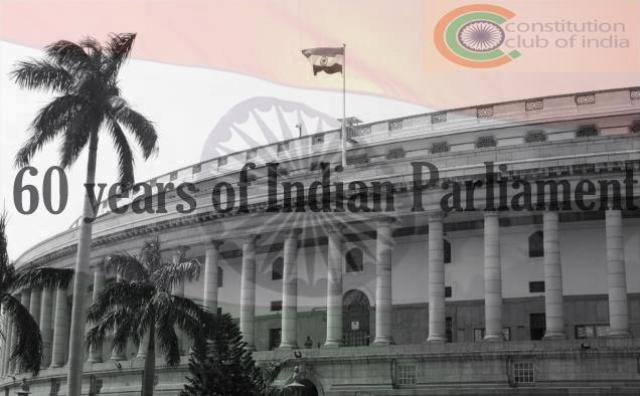 2012 archive photo from Central Hall Magazine. The magazine is based on the historic hall’s role as a place where members across party-lines and ideologies sit down together.
2012 archive photo from Central Hall Magazine. The magazine is based on the historic hall’s role as a place where members across party-lines and ideologies sit down together.
[This an excerpt from an article in The Round Table: The Commonwealth Journal of International Affairs. Opinion pieces do not reflect the position of the Round Table Editorial Board.]
Central Hall is unique to India. No other parliamentary bodies elsewhere appear to have anything similar. It is circular with a dome 30 metres (98 ft) in diameter. Although a century old in a city where older monuments abound, it is a place of historical importance.
The Indian Constitution was debated for over two years and framed in the Central Hall. Jawaharlal Nehru made his ‘Tryst With Destiny’ speech here heralding the birth of independent India.
It was originally used as the library of the erstwhile Central Legislative Assembly and the Council of States. In 1946, it was converted and refurbished into the Constituent Assembly Hall. At present, Central Hall is used for holding joint sittings of both the houses of parliament and also used for addresses by the President at the start of the first parliamentary session after each general election. This is also where MPs elect their Leader following each general election; he or she – the putative Prime Minister – is then invited by the President to form the next government for a five-year term.
The new complex of Parliament without the Central Hall may seem logical to the modernisers, but many will regard Central Hall as more than a mere structure. Its abandonment is tantamount to disrespecting the foundation on which the democratic edifice was built.
For seven decades Central Hall has served as a convenient neutral turf for government and opposition leaders to meet informally and to resolve many an issue on which strong disagreements may have manifested on the floor of parliament. Indeed, several controversies caused in either House have been amicably resolved thus.
Central Hall was parliament’s ‘human face’. While journalists have no access to the two Houses, they were allowed entry into the Central Hall to informally meet each other and the parliamentarians. This enabled the media to get a better understanding of how parliamentary democracy works.
Dubbed India’s most privileged coffee house – also the cheapest – Central Hall was where media could talk informally to the MPs, gain perspectives, even share political gossip.
To be sure, media’s presence has been both welcome and not-so-welcome depending upon the political developments in and outside parliament. Journalists have been seen as eavesdroppers, or carriers of crucial messages, depending upon the situation.
The re-think about Central Hall and the Central Vista seems to have begun with the start of the second tenure of Prime Minister Narendra Modi’s government. Bimal Patel, the architect chosen to draw up plans for the new Central Vista, including Parliament, reportedly said that when he revealed his blueprint for three halls in Parliament, Modi suggested that there was no need for the joint session hall; instead, a larger hall for the Lok Sabha to accommodate a joint session, and another for the Rajya Sabha were, in his view, sufficient.
Central Hall has been a veritable gallery of the greats of India’s democracy. Where and how 25 will portraits from Mahatma Gandhi to Rabindranath Tagore and Netaji Subhas Bose to six of the former prime ministers and many opposition stalwarts find their place? Will the 21st century parliament leave behind the hallowed traditions of the twentieth? Is the ‘restoration’ going to be selective, as those opposing the new complex fear, not unjustifiably?
Along with the Central Hall, an old world charm and grace are bound to disappear.
Mahendra Ved is a senior journalist Based in New Delhi and the President of the Commonwealth Journalists Association (CJA).



